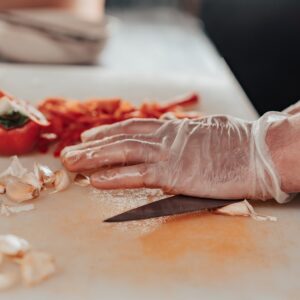Fresh herbs are nature’s aromatic and flavorful gifts to the culinary world. Their vibrant colors, delightful scents, and unique tastes can transform ordinary dishes into extraordinary culinary creations. Whether you’re a seasoned chef or a home cook looking to enhance your cooking skills, incorporating fresh herbs into your recipes can take your dishes to new heights. In this article, we’ll explore the art of cooking with fresh herbs and how they can elevate your culinary experiences.
Understanding the Power of Fresh Herbs
Fresh herbs are the leaves, stems, and sometimes flowers of certain plants that add fragrance and flavor to food. Unlike their dried counterparts, fresh herbs have a more intense and nuanced taste that can awaken the senses. The oils in fresh herbs, which hold their essence, are highly volatile, making them the ideal ingredients for infusing dishes with their distinctive character.
Some commonly used fresh herbs include basil, cilantro, parsley, mint, rosemary, thyme, dill, chives, and sage, among others. Each herb boasts its unique flavor profile, allowing for endless possibilities in culinary combinations.
Cultivating Fresh Herbs at Home
One of the joys of cooking with fresh herbs is the ability to grow them right in your backyard or windowsill. Cultivating your own herbs ensures a readily available supply of these delightful ingredients while also adding a touch of greenery to your living space.
To begin, choose a sunny spot for your herb garden, as most herbs thrive in sunlight. Herbs like basil, mint, and chives grow well in containers, making them perfect for small spaces. Use well-draining soil and remember to water your herbs regularly but not excessively. As they grow, remember to prune them to encourage bushier growth and to prevent them from bolting.
Harvesting Fresh Herbs
When it comes to harvesting fresh herbs, timing is crucial to preserve their flavor and potency. The best time to pick them is in the morning when the essential oils are at their peak concentration. Gently snip the leaves or stems using sharp scissors, pruning shears, or your fingers, and avoid pulling them off the plant, as this can damage the herb.
For most herbs, regular harvesting promotes growth and ensures you have a fresh supply throughout the growing season. However, be mindful not to overharvest, as it can weaken the plant and reduce its ability to regenerate.
Storing Fresh Herbs
To prolong the shelf life of fresh herbs, it’s essential to store them correctly. One effective method is to treat fresh herbs like cut flowers. Place the stems in a glass of water, similar to a bouquet, and loosely cover them with a plastic bag. Store the glass in the refrigerator, and your herbs should stay fresh for several days.
Another option is to preserve fresh herbs by freezing them. Chop the herbs finely, place them in ice cube trays, and cover with water or olive oil. Once frozen, transfer the herb cubes to a freezer-safe container. When you need them in a recipe, simply pop out a cube and add it directly to your dish.
Pairing Fresh Herbs with Foods
Each herb’s unique flavor complements specific types of food, and knowing how to pair them effectively can take your culinary creations to the next level. Here are some classic herb-food pairings:
- Basil: This sweet and aromatic herb is a classic companion to tomatoes and mozzarella, making it a staple in Caprese salads and Margherita pizzas. It also pairs well with pasta dishes, pesto sauces, and grilled meats like chicken and fish.
- Cilantro: Often associated with Mexican and Asian cuisine, cilantro adds a refreshing citrusy note to dishes like salsas, guacamole, curries, and stir-fries.
- Parsley: With its mild and slightly peppery flavor, parsley is a versatile herb that enhances a wide range of dishes, including salads, soups, stews, and grilled meats.
- Mint: This cooling herb is perfect for both sweet and savory dishes. It works wonders in desserts like ice cream and fruit salads and brings a refreshing touch to savory dishes like lamb, salads, and summer rolls.
- Rosemary: Known for its robust and pine-like flavor, rosemary pairs wonderfully with roasted potatoes, grilled meats, and hearty stews.
- Thyme: This earthy and slightly sweet herb is a classic addition to roasted vegetables, poultry, and hearty soups.
- Dill: With its feathery fronds and delicate taste, dill is often used in dishes with fish, cucumbers, and in pickling recipes.
- Chives: Offering a mild onion flavor, chives are great in salads, creamy dips, and as a garnish for soups and baked potatoes.
Experimenting with Fresh Herbs
Don’t be afraid to experiment with fresh herbs in your cooking. Their vibrant flavors can add depth and complexity to your dishes, making your meals stand out. Here are some ideas to get you started:
- Herb Butter: Mix finely chopped herbs like chives, parsley, or thyme into softened butter for a delightful spread on bread or a flavorful topping for grilled meat and seafood.
- Herb-infused Oils: Create your own herb-infused oils by steeping herbs like rosemary, thyme, or basil in olive oil. Drizzle these aromatic oils over salads or use them in cooking for an extra burst of flavor.
- Herbal Teas and Infusions: Make refreshing herbal teas by steeping fresh mint, chamomile, or lemon balm in hot water. You can also infuse water or sparkling water with herbs and fruits for a naturally flavored beverage.
- Herbed Salt: Combine finely chopped herbs with sea salt to create a flavorful herb-infused salt, perfect for seasoning a wide range of dishes.
- Herb Rubs: Mix various herbs with spices to create rubs for meat or vegetables before grilling or roasting. The herb-infused rubs will add layers of taste to your dishes.
- Herb-Infused Vinegars: Another wonderful way to use fresh herbs is by infusing them into vinegar. Choose a mild vinegar like white wine vinegar or apple cider vinegar, and add sprigs of herbs like tarragon, thyme, or rosemary to a clean glass jar. Seal the jar tightly and let it sit in a cool, dark place for a few weeks, shaking it occasionally. The result will be a flavorful herb-infused vinegar that can be used in salad dressings, marinades, and vinaigrettes, adding a delightful twist to your dishes.
- Herb-Infused Syrups: Fresh herbs can also be used to infuse syrups, creating a sweet and savory addition to cocktails, mocktails, and desserts. For instance, try infusing simple syrup with basil or lavender for a unique and aromatic twist. The herb-infused syrup can be used to sweeten lemonade, drizzle over pancakes, or mix into a creative cocktail.
- Herb-Marinated Meats: Take your grilled meats to the next level by using herb marinades. Combine finely chopped herbs with garlic, lemon juice, olive oil, and your choice of seasonings to create a flavorful marinade for poultry, beef, or seafood. Let the meat marinate for a few hours or overnight to allow the flavors to penetrate, resulting in tender and well-seasoned dishes.
- Herb-Crusted Fish: Create a flavorful and crispy coating for your fish by making an herb crust. Mix chopped herbs like parsley, dill, and thyme with breadcrumbs and press the mixture onto the fish fillets before baking or pan-frying. The herbs will infuse the fish with a burst of flavor, making it a delightful and nutritious meal.
- Herbed Compound Butters: Elevate your steak, grilled vegetables, or crusty bread by using herbed compound butters. Mix softened butter with minced fresh herbs, a dash of salt, and optional additions like garlic or lemon zest. Roll the mixture into a log using parchment paper and refrigerate until firm. Slice the compound butter and add it to your hot-off-the-grill dishes for a creamy, aromatic finish.
- Herb-Infused Creams and Sauces: Fresh herbs can bring an extra layer of flavor to creamy sauces and soups. For example, try adding chopped chives and parsley to sour cream or yogurt for a tangy and herbaceous dip. For a decadent sauce, sauté shallots and garlic in butter, then add cream and a generous amount of chopped fresh herbs to create a rich and aromatic sauce for pasta or meat.
- Herb-Packed Salads: Move beyond basic lettuce salads by incorporating an array of fresh herbs. Mix parsley, cilantro, mint, and dill with salad greens for a burst of freshness. Add toasted nuts, feta cheese, and a light vinaigrette to create a refreshing and delightful salad that celebrates the essence of summer.
- Herb-Infused Rice and Grains: Cooking grains like rice, quinoa, or couscous with fresh herbs can elevate their flavors and turn them into a delicious side dish. Add chopped herbs to the cooking water or stir them in after the grains are cooked for an aromatic touch that perfectly complements your main course.
- Herbs in Desserts: Fresh herbs can even make appearances in sweet treats. Mint and basil, for example, work wonderfully in desserts like ice creams, sorbets, and fruit salads. Lemon thyme or lavender can add a subtle, fragrant twist to cakes, cookies, and custards, offering a unique and surprising flavor combination.
- Herb-Focused Cuisine Exploration: Delve into different cuisines that heavily rely on fresh herbs as a cornerstone of their flavor profiles. For instance, explore Thai, Vietnamese, or Mediterranean cuisine to discover how these cultures skillfully incorporate an array of fresh herbs into their dishes.
Cooking with fresh herbs is a delightful journey of discovery, creativity, and culinary pleasure. The possibilities are endless, as each herb brings its unique charm and taste to the table. Whether you’re using them in simple salads, marinades, sauces, or exploring more intricate herb-infused creations, incorporating fresh herbs into your culinary repertoire will undoubtedly elevate your dishes and enrich your dining experiences. As you experiment with these aromatic wonders, you’ll find that fresh herbs have the power to turn an ordinary meal into an extraordinary feast, leaving your guests delighted and your taste buds craving more. Embrace the magic of fresh herbs, and watch as your culinary creations reach new heights of flavor and finesse. Happy cooking and bon appétit!




